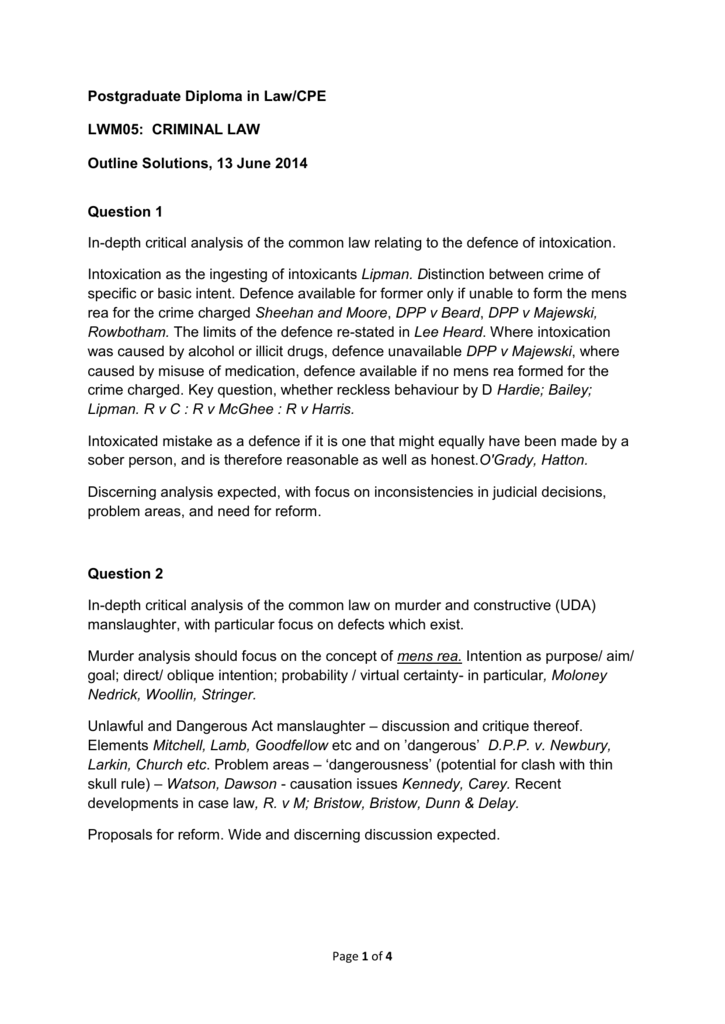![[BKEYWORD-0-3] Oblique Intent In Common Law](http://sambanksalevelrevision.weebly.com/uploads/3/0/2/8/30282277/3208126_orig.jpg)
Oblique Intent In Common Law Video
General v. Specific Intent Crime - Memorization \u0026 Help - Episode # 3 Oblique Intent In Common Law.Since all three were based on the same act against the same victim, he will only be punished for one. Understanding these charges, and how likely they are to be sustained on appeal, requires some background. Felony Murder The second-degree murder charge is based on the controversial felony-murder rule.

The California Legislature has abolished the rule to the extent that it can, being limited by a voter-enacted initiative. The felony-murder rule remains in force in most states, however, including Minnesota.
Recent Posts
Its roots go back to the common law. In the typical case, a charge of murder usually requires the prosecution to prove that the defendant intended to kill the victim.

Under the felony-murder rule, though, if a person is killed during the commission of certain felonies, all participants in the felony are guilty of murder. It does not matter who did the killing or whether it was intentional or accidental. There is wide http://rmt.edu.pk/nv/custom/due-to-the-transaction-costs-being-lower/essay-on-why-i-want-to-study-south-korea.php among states as to the breadth of the rule, particularly which felonies qualify.
It includes any felony except drive-by shootings and certain sex crimes, which are dealt with elsewhere.
Recent Comments
The inclusion of assault as the underlying felony in the felony-murder rule is particularly problematic. If one person strikes another with the intent to hurt but not kill and the target unexpectedly dies, including assault Oblique Intent In Common Law the underlying felonies bumps the crime up to felony murder, which in most states is a more serious click that some other kinds of Conmon. Homicide was the first crime to be divided into degrees, and state laws typically have a hierarchy in more detail than most other crimes. See People v. Moran, N. This kind of bootstrapping finds support neither in logic nor in law. Ireland, 70 Cal. Minnesota does not follow the merger doctrine. The Minnesota Supreme Court already had a history of rejecting it in when the legislature amended the law, moving felony murder up from third to Oblkque degree.
The Supreme Court in State v. Jackson, N. The crime traditionally known as voluntary manslaughter is first-degree manslaughter in Minnesota. See Minn.

Intentional infliction of bodily harm is assault. Logically, it would seem that everyone who commits voluntary manslaughter also commits felony murder. And, as the Ireland court said, that is not logical.
Visitor Visa proof of intent to leave Canada
Can Chauvin appeal, arguing that Minnesota should now embrace the merger doctrine? Will he succeed? Not likely. First, the case would have to go to the Minnesota Supreme Court, as only that court can overrule its own precedents on state law. Second, even if the court were inclined to overrule Jackson, I doubt it would use this case to do so. Kidnapping, rape and other forcible sex crimes, robbery with a deadly weapon, and burglary of a home while armed with a deadly weapon should qualify.]
I congratulate, your idea is very good